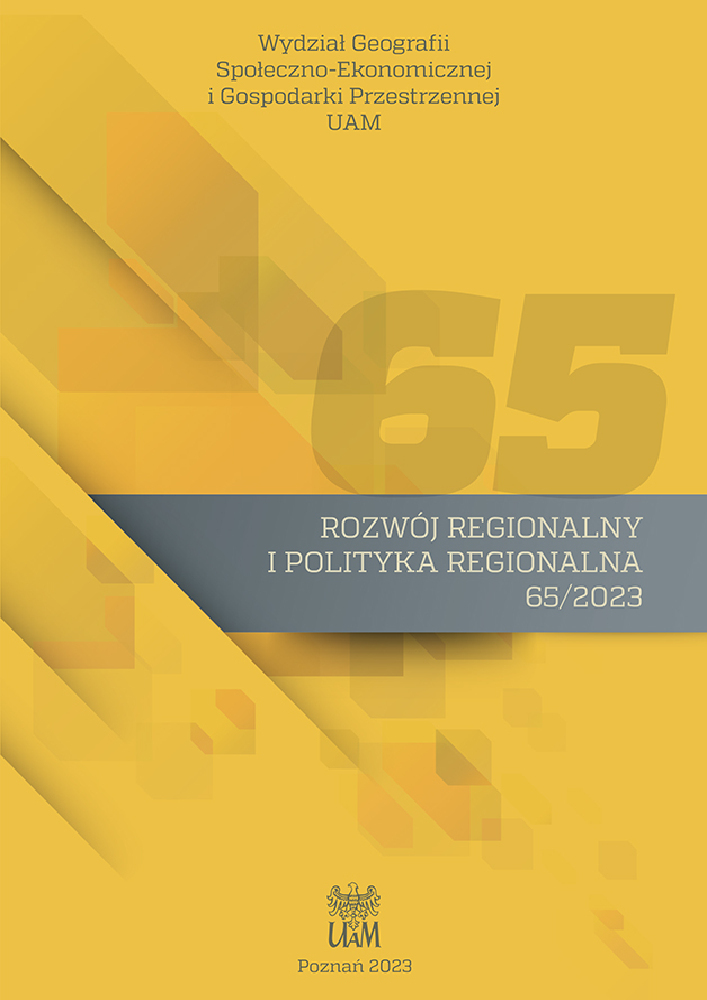Abstract
The exclusion of women from civil and political rights in the first half of the 20th century, albeit partial, also concerned countries with developed democracies, such as France, the United States, Belgium and Switzerland. Right after the revival of its statehood in 1918, Poland – just as some other newly developed countries in Europe – granted women universal suffrage. The study aims to show the political activity of women in terms of their participation in the Sejm (Polish parliament) elections between 2007 and 2019, which is nearly a century after establishing their civil rights. From the geographical and electoral point of view, it is important to characterise a spatial variability of selected aspects of women’s electoral activity (four indicators) and determine mechanisms affecting changes in this field.
Given the most popular indicator for women’s electoral activity, i.e., the percentage of seats they won in the Sejm, one may recognise that the political participation of women in this area in the years 2007–2019 was progressive. However, when analysing other indicators presented in this work, it may be stated that changes in women’s electoral activity are more complex. After introducing the quota rule, it became obvious that the number of female candidates on electoral lists increased from 23.0% in 2007 to as much as 43.6% in 2011, but it dropped, admittedly slightly, in the subsequent elections. On the other hand, the proportion of the votes gained by women peaked in 2015, reaching 32.4%, and in the next elections in 2019, it decreased a little to 31.6%. The electoral possibilities of women are also evidenced by an indicator of their relative efficacy. Countrywide, this indicator did not exceed the value of one in any of the analysed elections, which means that men are more effective in obtaining votes.
In terms of spatial variability, women’s electoral activity in the discussed range of topics does not exhibit durability by constituencies. Only a few of the voting districts have lasting above-average electoral properties (although these also fluctuated up and down sometimes) at national level. Thus, it seems that spatial variability was formed by short-term electoral strategies of political parties (the movement of candidates from one constituency to another, ignoring the territorial origins of the candidates, promotion of more popular parliament members to the European Parliament) rather than by socio-cultural and economic factors typical of those constituencies.
References
Chełstowska A., Druciarek M., Niżyńska A., Skoczylas N. 2015. Udział kobiet w wyborach parlamentarnych w 2015 roku. Wyniki monitoringu obserwatorium równości płci. Instytut Spraw Publicznych – Heinrich Böl Stiftung, Warszawa.
Gendźwiłł A., Żółtak T. 2020. Do parties and voters counteract quota regulations? The impact of legislative gender quotas on ballot ranking and preference voting in Poland. Politics & Gender, 16(1): 199-229. DOI: https://doi.org/10.1017/S1743923X18000880
Górecki M.A., Kukułowicz P. 2014. Gender quotas, candidate background and the election women: A paradox of gender quotas in open-list proportional representation systems. Electoral Studies, 36: 65-80. DOI: https://doi.org/10.1016/j.electstud.2014.06.009
Gwiazda A. 2017. Women in Parliament: Assessing the Effectiveness of Gender Quotas in Poland. Journal of Legislative Studies, 1-22. DOI: https://doi.org/10.1080/13572334.2017.1358981
Harrop M., Miller W.L. 1987. Elections and voters. A comparative introduction. Macmillan Education Ltd., Houndmills–London. DOI: https://doi.org/10.1007/978-1-349-18912-0
Janicki K., Kuzak R., Kaliński D., Zaprutko-Janicka A. 2020. Przedwojenna Polska w liczbach. Wydawnictwo Bellona, Warszawa.
Kulczyńska K., Matykowski R. 2022. Osie rywalizacji w wyborach do Sejmu w województwie wielkopolskim w XXI w. Wybrane zagadnienia. Rozwój Regionalny i Polityka Regionalna, 62: 63-85. DOI: https://doi.org/10.14746/rrpr.2022.62.05
Matykowski R., Kulczyńska K. 2016. Wybory do Sejmu w 2015 roku w województwie wielkopolskim: odmienności przestrzenne w kontekście subregionalnym i lokalnym. Rozwój Regionalny i Polityka Regionalna, 36: 163-178.
McCann J. 2013. Electoral quotas for women: An international overview. Research Paper, 14, Parliament of Australia, Departament of Parliamentary Services.
McGing C. 2015. Towards a feminist electoral geography. Political Geography, 47: 86-87. DOI: https://doi.org/10.1016/j.polgeo.2014.07.007
Niewiadomska-Cudak M. 2013. Walka o prawa wyborcze kobiet w Polsce. Pedagogika Rodziny, 3/1: 55-64. DOI: https://doi.org/10.2478/fampe-2014-0006
Stelmach A. 2013. Mechanizmy zwiększania partycypacji kobiet w wyborach. Środkowoeuropejskie Studia Polityczne, 4: 7-24. DOI: https://doi.org/10.14746/ssp.2013.4.01
Tripp A.M. 2003. The changing face of Africa’s legislatures: Women and quotas. Konferencja „The implementation of quotas: African experiences”, Pretoria, November 2003.
Women in Parliament in 2006: The year in perspective. 2007. Inter-Parliamentary Union, Geneva.
Women in Parliament in 2012: The year in perspective. 2013. Inter-Parliamentary Union, Geneva.
License
Copyright (c) 2023 Katarzyna Kulczyńska, Roman Matykowski

This work is licensed under a Creative Commons Attribution 4.0 International License.

